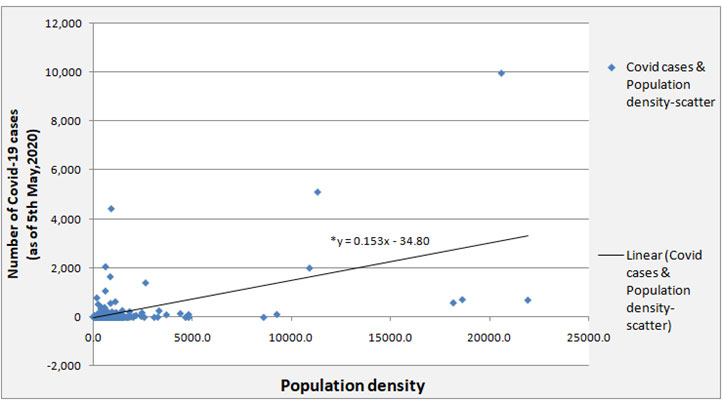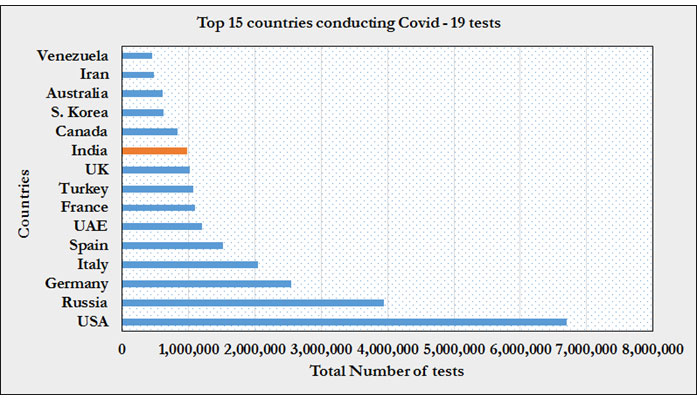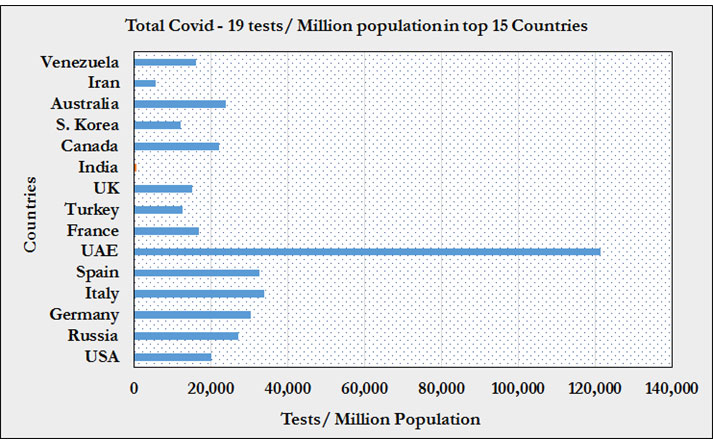The impact of the ongoing Covid pandemic is turning out to be multidimensional, and among the long-run considerations that it has brought to the fore are population and pollution. In the run up to World Environment Day on 5 June, Rishabh Mahendra and Shweta Gupta discuss these issues in the context of the current crisis, and draw policy lessons for the future.
It has now been over six months since the outbreak of Covid-19 and it has affected over 6.4 million people and taken more than 378,000 lives so far, globally. Of the currently active cases, 3.04 million people are infected with mild conditions and about 54,200 are serious or critical1. The virus has created a heart-breaking impact globally, bringing economic and developmental activities to a state of fragility for several countries, and is hence being considered the most serious threat since World War-II.
While medical professionals are busy treating the affected, and scientists are working on developing a vaccine for the disease, several governments across the globe have decided to lockdown (from extreme to mild) their economies. Lockdowns have resulted in shutting down of various sectors in the economy. Due to Covid, almost 1/3rd of the world's population is living under lockdown. The impact of this pandemic is likely to be multidimensional, creating a health crisis in the first instance – with spillover effects including hunger crisis, deepening of poverty, recession, and disequilibrium in the supply chain. There are two other aspects that are important for the long run, and that this pandemic has brought to our attention: pollution and population (density).
Covid-19, lockdown, and pollution
Given the current healthcare capacity of India, there was no measure better than a lockdown to begin with. While there are appalling socio-economic outcomes of the lockdown, such as the migrant crisis, it has put in front of us several examples of improvement in environmental quality, which can give the world lessons for a lifetime. Animals are coming out of forests and walking freely on roads, more birds are migrating to their preferred destinations, aquatic beings are seen at places that they had abandoned ages ago, and there are sights of improved air and water quality. A few of these instances in India include:
- Cleaner air (based on Air Quality Index) near India Gate war memorial was observed after the first lockdown of 21 days.
- Due to less emission of industrial pollutants, Delhi’s Yamuna River is clearer now – an indication that cleaner rivers are not impossible to achieve.
- People in some parts of the country claimed that, for the first time in years, the Himalayas were visible to them from a distance – Gangotri peak visible from 300 km away; Himalayas visible for the first time in 30 years from 100 miles away.
There have been four phases of lockdowns in India, adding up to 68 days (the 5th phase has just begun on 1 June), that have put constraints on movement of people and economic activities. Since the major economic activities responsible for emission of various air pollutants, such as CO2, CO, PM2.5, PM10, NO2, SO2, O3, and Benzene, are on halt, India has experienced an improvement in air quality. A report published by the Central Pollution Control Board, focusing on the first lockdown period in Delhi, finds that there has been almost 46% and 50% reduction in the concentration of PM2.5 and PM10 respectively, as industrial emissions and combustion of fossil fuels have declined. Similarly, due to negligible use of transportation services and restrictions on vehicular movements, the concentrations of NO2 and CO have declined by 56% and 37% respectively. There is also a reduction in the emission of Benzene by 47%. The fall in concentration of SO2 is relatively less as its prime source – power plants – are still functioning.
Why being happy about cleaner air during lockdown should not be considered insensitive
There are several reasons pertaining to environmental consciousness, but discussion on that is for a different time. Even during a general scenario, for low- or middle-income countries, a large share of the death rate is associated with air pollution. Air pollution killed 1.24 million people in 2017 globally and is the 3rd biggest cause of deaths in India, indicating the severity of air-borne diseases. Since the outbreak of Covid-19, several studies have been conducted to find ways to reduce the impact of the pandemic. In one such nation-wide study conducted on the US, public health officials claimed that polluted air and intensity of the impact of Covid-19 are positively correlated; that is, places with high levels of pollution have higher numbers of patients and the seriousness of the disease for these patients is greater too, on account of lower immunity of people suffering from air-borne illnesses.
In India, the concentration of harmful air pollutants is high. Hence, the severity of cases in India in terms of respiratory discomfort may have been greater had the lockdown not improved air quality.
A question in the minds of many people who are concerned about global climate is: what would happen to the environment once the lockdown ends? The changes in environmental quality right now are short term, that is, they are temporary effects of lockdown that has been enforced for reducing the spread of Covid-19. It is termed as ‘weather change’, which is a mix of events that happen in our atmosphere every day. However, what really matters is ‘climate change’ – a long-run phenomenon where weather changes are observed over a long period of time in a specific area. These are certainly times that may encourage world leaders to find ways to achieve the goal of limiting global temperature rise to 1.5°C (or even lesser) by 2030.
Covid-19 and population
A key determinant of the spread of Covid has been identified as population density. The possibility of the outbreak of the disease and its spread is higher in areas that have higher population densities as denser population catalyse the spread of the virus. India, due to strict lockdown, has seen a slower rate of growth in cases in the initial phase. However, within India, the cases have spread relatively faster in high-density cities/towns such as Mumbai, Delhi, Ahmedabad, Surat, Pune, Chennai, Indore, Jaipur, etc.
Along with population densities, the other factor that affects the reported number of cases is the amount of testing that is being done. Figures 1(a) and 1(b) show the top 15 countries in terms of testing, and tests per million population in those countries, respectively. Ten countries (US, Italy, Spain, UK, Germany, Russia, France, Turkey, Canada, and Iran) of these 15 countries have reported the highest Covid-19 cases. Among the other five countries, India has reported the lowest tests per million population, and even though testing has been low, cases have still been increasing (Figure 2).One can infer that higher testing in India could have resulted in higher reported cases, which certainly would shoot up the numbers exponentially in dense locations.
Figure 1(a). Top 15 countries conducting Covid-19 tests
Figure 1(b). Total Covid tests/million population in top 15 test conducting countries
Figure 2. Trend of total confirmed cases of Covid-19 in India (30 January-5 May 2020)
On running a correlation test between the district/city-wise confirmed Covid-19 cases in India (as on 5 May 2020) and their respective population densities we found a strong positive correlation of 0.54. And a simple linear regression2 of the impact of population density on confirmed Covid-19 cases showed that, an increase in population density by one person per square kilometer increases the risk of a person testing positive by 0.153 units in a given city/district. In other words, if the population density in a city/district increases by 6.5 persons, it is highly likely that one additional positive confirmed case of Covid-19 in that city/district would arise. Based on the number of cases on 24 April, the likelihood of one additional Covid-19 confirmed case required population density to increase by 14 people in a city/district.3 It is also important to note that this relationship could have worsened had there been no lockdown in India or if people had not followed the lockdown as much as they have.
Figure 3. Confirmed Covid-19 cases and population density of Indian cities/districts

Sources: (i) Covid-19 confirmed cases - covid19india.org; (ii) Population and area of cities/districts – Office of the Registrar General & Census Commissioner, India (ORGI), and official website of district administration for districts formed after 2011.
Note: * refers to the equation of trend line.
Population and pollution
It is a well-known fact that population growth has resulted in environmental degradation. Not every person in a population contributes directly to global warming, but almost everyone does indirectly. Several environmental cycles (carbon, water, nitrogen, etc.) are hindered by human activities, and this is causing major environmental damages and global climate change.
According to the population pressure hypothesis, growth in numbers (of population) causes land to be used more intensively. It creates a very high demand for things such as food, energy, buildings, cooking fuel, transportation, etc., generating pollutants of all kinds. In order to fulfil these demands, production activities have to increase, involving degradation and depletion of natural resources. According to an observation by NASA (2013), exposure to air pollution is higher in denser cities. However, they also pointed out that concentration of pollutants varies across different geographies, giving an example that a city with one million population in Europe has six times higher concentration of nitrogen oxide than a city in India with the same level of population. A deeper analysis into this direction can help understand other reasons for the severity of Covid-19 cases in some parts of the world.
Increase in population densities is leading to pollution that can be harmful to humans directly, and will affect humans in several other ways by triggering a quicker rise in global average temperatures. As the world has been looking for long-term, effective and efficient measures with respect to climate change, the current Covid-19 situation has set a platform that can help devise them.
Economic-environmental trade-off as a result of economies of agglomeration
Economies of agglomeration refer to opening several production units close to each other as a part of cost-cutting strategy. This on one hand leads to urbanisation and increases economic growth, while on the other hand it instigates stress that harms the health of the environment. The factors of economic growth that agglomeration generates include employment, technology, connectivity, etc. Due to better economic structure and availability of better healthcare and education facilities, these contribute to an increase in the population concentration in urban areas. And higher population concentration creates congestion, delay in travels, noise pollution, and other environmental degradation. Urban hotspots release relatively higher amounts of greenhouse gases and various other pollutants. Hence, economies of agglomeration may lead to economic growth, but also come with great environmental costs that are difficult to measure. Agglomeration, in the current situation, has indirectly turned out to be a medium for the spread of Covid-19, across the globe.
We provide seven wide-ranging recommendations, as to how India (and similarly other economies) can address its population and pollution concerns. Our recommendations may have limitations as these are complex problems with no straightforward solutions. These limitations provide room for further research and analysis.
Recommendations
Immediate measures
Promotion of work-from-home culture as a regular practice: Due to lockdown, various organisations that could function with their employees working remotely asked their employees to work from home. This did come with its limitations, but there was no other option. Studies have suggested that flexible working hours results in higher productivity and better work-life balance. Governments can plan to make this a norm, such that companies limit their work-from-office days and provide their employees with at least one work-from-home option every week. This will reduce the number of vehicles on the road, leading to reduced congestion and pollution. With such an arrangement, employers and employees will be prepared to face a situation like the current lockdown situation, should it arise in the future.
Encouraging use of e-vehicles: The need for social distancing and fear of crowded spaces is likely to make some people switch from public to private modes of transport. It is anticipated that there will be a rise in demand for second-hand cars and bikes, post lockdown. From an environmental (or eco-economic) perspective it would be ideal that the government uses this opportunity to encourage the use of e-vehicles by addressing associated challenges such as high upfront costs, charging infrastructure etc.
Congestion tax and strengthening public transport: In a country like India, private modes of transportation are not just needs (flexibility, comfort, etc.) but have also become status symbols. The indiscriminate use of private vehicles causes congestion, air and noise pollution, and increase in the number of road accidents. Hence, it is essential to formulate policies and plans that can make the use of public transport (bus, train, metro, etc.) more attractive4. Congestion taxing has already been implemented in a few cities (Singapore, London, Stockholm, and New York), but there is a need for consensus to make this possible wherever required. Besides addressing issues associated with traffic congestion in densely populated cities/towns, the revenue can be used for improving the quality and quantity of public transportation.
Long-term measures
Modernising technology or eco-economic decoupling: Human population is increasing and that is leading to increased demands for various goods. Though there are technological advancements that help in improving productivity of a resource, but in absolute terms, the resources keep depleting. Hence, it is essential to determine the maximum population size that the Earth can sustain (also known as carrying capacity). This needs to be supplemented with greater efforts to shift towards renewable, clean sources of energy and invest in cleaner technologies. Eco-economic decoupling or decoupling natural resource use means to reduce the rate of use of (primary) resources per unit of economic activity. The idea does not imply that humans should be left to starve or be forbidden to access resources; it instead advocates for reducing environmental impacts of the production activities.
Providing Urban Amenities to Rural Areas (PURA): This is an idea that was proposed by former President of India Dr. APJ Abdul Kalam to promote inclusive development. In 2011, 31.36% of the urban population lived on just 6.77% of the total land area in India. Hence, it is quite evident that there is a higher pressure on natural resources in urban areas, which needs to be alleviated. Advanced technologies and infrastructure should be introduced in rural areas in an equitable manner, which would encourage MSMEs (micro, small, and medium enterprises) to set up in villages/towns with low population density. By creating opportunities in rural areas, PURA will reduce out-migration, which in turn will help reducing the distress migrant labourers go through.
Developing climate smart cities instead of smart cities: According to Sustainable Development Goal (SDG) 11, to achieve sustainable development, the cities and human settlements must be inclusive, safe, resilient and sustainable (environmentally). Planning of cities and urban infrastructure should adopt a greener (eco-friendly) approach, targeted at a more uniform spread of population rather than concentration in a few hotspots. This can be done by ensuring every new building is a green building, there is expansion of green cover, air quality is improved, and there are good water and waste management policies in place. Every region should work out a target range of population density that is sustainable, and adopt measures taken to attain it.
Shifting from a linear to circular economy: Due to supply-chain disruptions, we have had lesser resources to run our day-to-day activities, which have helped us realise that we can meet our needs with fewer things. This experience can make it easier for us to try and shift from a linear form of economy to reuse or circular economies, in the post-Covid world. A reuse economy is one where raw materials go into the production process and the waste that is generated is recycled and reused until it becomes a non-recyclable waste, and then it is dumped into the environment. A better way is when that non-recyclable waste is put to use too. Circular economy, on the other hand, lies more towards the idea of sustainability as it functions on the ideas of reducing consumption, and recycling by both producers and consumers, along with reuse. The functioning of a circular economy should not just be considered an economic structure but a way of living. From producers to consumers, it is the responsibility of every single unit of an economy to contribute towards better and efficient use of natural resources. A circular economy (or at least reuse economy) will help improve in productivity, which in turn will also lead to profitability. Examples of such policies include use of plastic to make roads in India, Singapore’s landfill deployment model, and Armenia’s water management system.
The authors are grateful to Dr. Pronab Sen for his valuable feedback. Any errors are their own.
Notes:
- Data taken from Worldometer database on Covid-19 on 2 June 2020.
- The regression result was significant at 99% confidence interval, with r-square of 29.6%. These results are assuming other factors don’t change, such as number of tests, air pollution concentration, intensity of lockdown, etc.
- A similar study conducted in the US yielded similar results.
- According to government data, a report was published in Times of India, which stated that India only has 4 buses for every 10,000 people, while China has 6 buses for every 1,000 people.
Further Reading
- AFIDEP and PAI (2012), ‘Population, Climate Change, and Sustainable Development in Kenya’, African Institute for Development Policy (AFIDEP) and Population Action International (PAI), Nairobi and Washington, DC.Barr, J and T Tassier (2020), ‘Are crowded cities the reason for Covid-19 pandemic?’, Scientific American, 17 April 2020.
- Central Pollution Control Board (2020), ‘Impact of lockdown (25th March to 15th April) on air quality’, Ministry of Environment, Forest and Climate Change.
- Dovers, S and C Butler (2015), ‘Population and environment: a global challenge’, Australian Academy of Science.
- Friedman, L (2020), ‘New Research Links Air Pollution to Higher Coronavirus Death Rates’, The New York Times.
- Hansen, K (2013), ‘NASA Scientists Relate Urban Population to Air Pollution’, 19 August 2013.
- Mair, S (2020), ‘How will Corona change the world?’, BBC News, 30 April 2020 .
- Pal, S (2020), ‘How costly are flawed government responses to Covid-19? An assessment of the migrant crisis’, Ideas for India, 3 May 2020.
- Pascual, U and E Barbier (2003), ‘Modelling land degradation in low-input agriculture: The ‘Population-Pressure Hypothesis’ revised’, International Association of Agricultural Economists.
- Ponkshe, A (2019), ‘Can congestion pricing be a solution to Mumbai’s traffic snarls?’, Observer Research Foundation.
- India State-Level Disease Burden Initiative Air Pollution Collaborators (2018), “The impact of air pollution deaths, disease burden, and life expectancy across the states of India: The Global Burden of Disease Study 2017”, The Lancet Planetary Health, 3(1): e26-e39. Available here.
- The World Bank (2015), ‘Water in Armenia - from Shortage to Abundance’, The World Bank Feature Story, 1 July 2015.
- Wu, X, RC Nethery, M Benjamin Sabath, D Braun (2020), ‘Covid-19 PM2.5: A national study on long-term exposure to air pollution and covid-19 mortality in the United States’, Harvard University.




 03 June, 2020
03 June, 2020 








By: Anshul singla 06 June, 2020
Your article was excellent. You have included everything in your article about pollution and population, but the biggest problem created by kovid is unemployment. I think you should have included this topic in your article..